Mike Vardy's Blog, page 95
October 20, 2014
The Evolution of Contexts
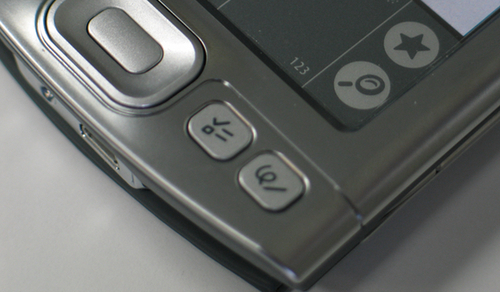
My podcasting partner-in-crime Michael Schechter posed this challenge to me on Twitter:
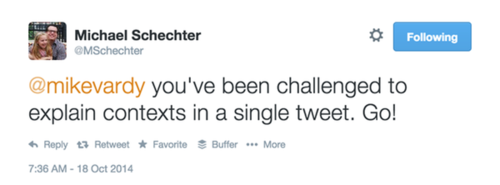
That was quite the challenge, but I took it.
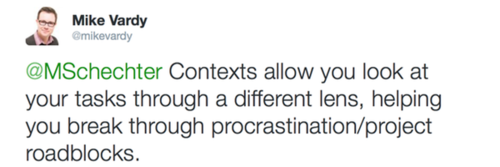
After that exchange, I saw a flurry of follow-up activity that was great to see. Several people had their own thoughts on what contexts were (and weren’t) and Schechter joined the fray with his own definition later on in the thread:
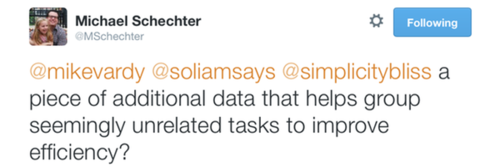
The question mark at the end was telling: There are so many different ideas of what contexts are that I think it is worth examining them not only from the vantage point of what they were initially defined as in David Allen’s book Getting Things Done, but how they have evolved in the years since the book was released.
The Original DefinitionI’ve written about contexts before, explaining how I use energy levels as my main ones. But energy levels don’t appear to be factored in when looking at the basic definition of contexts offered in David Allen’s seminal work, Getting Things Done.
”Context lists can be defined by the set of tools available or by the presence of individuals or groups for whom one has items to discuss or present.” - - via Wikipedia
As more people adaopted GTD, and luminaries such as Merlin Mann added perspective, contexts began to change in order to accommodate more effective and efficient workflows. In fact, as contexts evolved they seemed to merge with the other elements of The Four-Criteria Model for Choosing Action in the Moment: Time Available, Energy Available, and Priority.
The Evolved DefinitionThis definition is much harder to pinpoint, as noted at the beginning of this piece, because there are more variables to consider.
Firstly, technology plays a much more prevalent role today than it did when the book was released. Take a listen to Mac Power Users 219 where David Sparks and Katie Floyd talk with David Allen about GTD and technology. Much like the ways you can capture, the ways you can define context can differ significantly. David Allen uses his trusted GTD Notetaker Wallet while David Sparks uses Drafts 4. I’m sure both of them use other methods, but in that episode they highlight those method as important ones for them. I use paper (with The Strikethrough System as a means to process my captured stuff) and digital tools almost equally, with Drafts receiving more usage the more familiar I get with Drafts 4. The point is that neither way is wrong or right. The point is that as long as you’re capturing consistently then you’re on track to get more of the right stuff done, which frees your mind to help you with processing your tasks instead of simply holding them.
The same goes for contexts. Through my experience in social interactions and through Productivityist Coaching, I’ve observed that some people are really into using the traditional contexts as laid out by David Allen. Most of these people are either still trying to adopt GTD or are GTD purists, so this makes sense. Other people are using “modes” to define what tasks they should work on, with contexts such as “Work Mode” and “Fun Mode” to chunk down their tasks to a more “doable” state. Sven Fechner has talked about energy levels as contexts, and I’ve followed suit. Some people use time intervals as contexts (i.e. “-5min” and “+30min”) in order to manage both their tasks and their time better. There are numerous ways to add context to your tasks and, as Schechter pointed out in his tweet, they are all forms of data.
But not everyone resonates with the word data. Even the word “information” seems cold to some. That’s why I often say the following when I try to explain contexts, which is something I couldn’t convey in 140 characters or less:
”Contexts add value to your tasks so that you can connect with them better. This allows you to use them to work on your tasks and projects through different lenses.”
When I took that idea to Michael Schechter in an email, he also added some valid points:
"Contexts are far from the only thing that adds value to a task. They only help you connect better with tasks if you use them well. And more often than not, their true value is in connecting multiple tasks rather than connecting you to a single task. It also does more than allow you to use them to work through different lenses. It forces you to first understand that you need different lenses to do your work, and then serves as them."
What contexts you need to use to add value to your tasks and projects is purely subjective. What isn’t subjective is that using contexts is crucial because they give you those additional lenses with which to guide your work. At the most basic level, they help you organize your to-do list in different manners to support your workflow in a better fashion.
And when you use them well, they allow you to shift gears more effectively, which puts you in the position to work more efficiently over the long term.
If you’re not using contexts yet, then you’re selling yourself- and your workflow - short. Take some time to build, filter, and foster your contexts in a way that supports your workflow. It may be taxing in the short term to set them up, but you owe it to yourself in the long run to do so.






 Related StoriesHow I Use Priority Levels in TodoistA Look at Productivity and Workflow "Versioning"The Quest for "Just Right"
Related StoriesHow I Use Priority Levels in TodoistA Look at Productivity and Workflow "Versioning"The Quest for "Just Right"
October 16, 2014
How I Use Priority Levels in Todoist
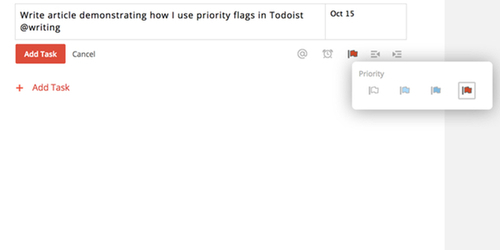
Todoist has been my task manager for some time, and one of the features it offers is the ability to flag tasks as needed. I have avoided using priorities until recently, but I finally figured out how I wanted to use them and have started to add them to my Todoist workflow. One of the key points about using them is that I’ve made a point of using them sparingly, as Gregory McKeown suggests in his book Essentialism.
“The word priority came into the English language in the 1400s. It was singular. It meant the very first or prior thing. It stayed singular for the next five hundred years.” - Gregory McKeown, Essentialism*
Prioritization has gotten out of hand over the years, and the addition of three different levels of priority flags in Todoist could very well add to the problem rather than help get prioritization back under control. For those unfamiliar, here are the types of priority flags in Todoist:
Red: Priority 1 or P1
Blue: Priority 2 or P2
Light Blue: Priority 3 or P3
You could argue that there is a fourth type – an item that is unflagged – but I don’t believe the clear flag is a flag at all. Instead, it’s more of a signifier that the level of priority is non-existent for that task. (To be fair, all tasks have some form of priority, but that’s a topic for another article.)
The great thing that Todoist has done is not endow any of these priority flags with any sort of predetermined meaning other than level of importance. For example, Priority 1 could mean "due today" or "due over the next three days" while Priority 2 could mean "due this week." It’s all very subjective, which makes the tool all the more personal. That said, if you are sharing projects with others then it’s crucial that everyone be on the same page in terms of defining what each priority flag means for the team.
In my mind, less is more when it comes to using these flags. That’s why I pair up priority flags with Labels and using them in Filters. But I only use these types of Filters for highly important tasks, not urgent ones. For example, I have a label called “@writing” and what I’ve done is created a filter that allows me to be very proactive with my writing tasks. Here’s the search term:
P1 & @writing & 30 days
I also have another filter that removes the priority flag from the equation, but what the above filter does is push the really important writing to the forefront.
I’ve done the same with any sort of administrative tasks that need to be done, as I’ve got an “@admin” label as well. If anything else, the priority flag takes the place of my high energy and low energy labels in these cases, acting as a trigger that trumps energy levels altogether. As a result, when something is flagged as top priority, it gets attention because it is associated with my main work (writing) and I use the flags sparingly enough that I can’t help but take notice.
I have started to use the second priority flag as well, flagging tasks that I want to ensure I keep tabs on and yet don’t have due dates associated with them as of yet. The difference in flag colour is what matters more in this use case than how Todoist treats the flags themselves (red flags are always at the top of any project or filter view in Todoist, only trumped by any task that has a time of day attached to it). Once I assign a date to a task that has a P2 flag, the flag gets removed because the task will show up in a filtered view at that point and that negates the need for the flag. Flagging with that second tier flag also ensures that when I conduct a weekly review that those tasks stand out more, and they need to because with no date assigned to them they can get lost in the weeds.
The key to using priority flags (or flags of any sort) is that if you use too many of them then they lose their power. If you are intentional with their uses, consistent with their uses, and ruthless with their uses, you’ll be able to give the tasks they are associated with the attention that they deserve - and when they deserve them.
I’d love to hear how you’re using flags like this, whether in Todoist or not. Share them in the comments below.






 Related StoriesThe Top 3 Things to Consider When Choosing a Task ManagerA Look at Productivity and Workflow "Versioning"The Quest for "Just Right"
Related StoriesThe Top 3 Things to Consider When Choosing a Task ManagerA Look at Productivity and Workflow "Versioning"The Quest for "Just Right"
October 13, 2014
Taking Traveling, Talking, and Trying to the Next Level
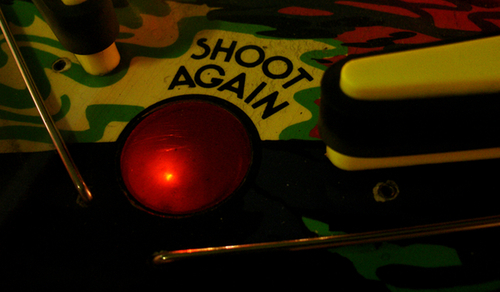
This past week – my first small sabbatical – was definitely needed. During the last couple of weeks I've taken traveling, talking and trying to a whole new level.
The sabbatical was well-timed as I needed a break from all the travel I’d undertaken. The travel was rewarding, make no mistake, but it was taxing. I knew that going in, which allowed me to enjoy it all the more.
There were several stops during my travel schedule, but here were the highlights:
Productivityist Coaching
I was able to do some in-house Productivityist Coaching for the first time ever. There’s something about spending time one-on-one with clients over Skype, but it’s altogether different when you’re right next to them. The connection was all the greater for them, but being there in person really allowed me to convey my passion for productivity in a whole new way. I’ve given plenty of talks and workshops on the subject, but never individual sessions. On this trip I was able to offer three of them, and it wasn’t just rewarding for the client, but for myself as well.
I’m currently offering 50% a one hour session of Productivityist Coaching to interested clients. Just click on this link, select the one hour session, and upon checkout enter the offer code GRETZKY to get one hour of Productivityist Coaching for just $100. This offer expires on October 15th, so take advantage of it today!
Speaking
On this trip I gave my first ever keynote at the NYSBA Digital Leadership Academy event. It was truly an honour to have followed a speaker with such presence as Seth Godin at this event, as he had spoken at it in 2012, and my talk “Don’t Just Ship…Deliver” was able to refer to his “shipping” philosophy and still speak to the core message of being productive rather than “doing” productive that I strive to convey.
My presentation solution of choice is now Haiku Deck. I was able to build my slide deck on my iPad and use my iPhone to present in a way that even wowed the seasoned technical crew. If you haven’t looked at Haiku Deck yet, I strongly recommend you do. I’ll be using it for every presentation I do for the foreseeable future.
The Minneapolis-St. Paul area was my last stop, and I got in less than 24 hours before I was to deliver my talk at the inaugural SimpleREV.
SimpleREV is an event that - at its most basic - celebrates the art and craft of living simply. My talk focused on the idea of focusing on task over time in order to really live a more simple life, as being task-oriented simplifies things in a way that time does not. I had an amazing (although abbreviated) time at the event, and would like to thank Joel Zaslovsky of Value of Simple and Daniel and Vanessa Hayes of Simple Life Together for having me present at this truly stellar event. I’m really looking forward to where the SimpleREV movement goes, and reconnected with so many wonderful people while there all while meeting other for the first time that truly embody the spirit of simple living.
I also got to finally meet Patrick Rhone in person after years of conversing online. We had a great time and I can't wait to see him again.
How I Made This Trip Work
This trip was definitely a whirlwind. I was on six airplanes, four trains, one boat, and several Uber and cab rides throughout. I managed to keep up with my work obligations for Productivityist by being proactive, and was able to travel with just my iDevices as a result. I’m going to discuss how I made all of this work in the next episode of The Productivityist Podcast, which goes live on Tuesday.
If you’re not already listening to the podcast, you can find it here. The podcast will always be free, but if you’d like to support the podcast, I’m running a Patreon campaign to help me take things to the next level. You can learn more about that here.
Beyond Trying
The travel schedule I kept earlier this month can be trying. It can be trying for not only the person doing the travelling, but for those affected by it. It can take a toll on productivity…and a lot more.
That’s why I have timed the release of my newest compendium eBook so that it launches in limited release today.
First off, it’s Thanksgiving in Canada. I’m feeling incredibly grateful for all of those who have read my work, listened to my podcasts, watched my speak over the years and I wanted to unveil my latest product on a day where gratitude is celebrated. Secondly, I re-read all of the pieces I chose for the eBook and noted that after such a hectic schedule that they really offered some solid perspective. Thirdly, it’s been too long since I’ve delivered an eBook of any kind that could be purchased.
So I’m offering my latest effort – Beyond Trying – to Productivityist readers today.
Beyond Trying is an eBook that compiles some of the best work I've written at Productivityist since its transition from a personal blog to its present state. Featuring three formats (PDF, EPUB, and MOBI), you'll get 23 articles of various lengths delivered in one easy-to-digest eBook format.
I’m also offering Beyond Trying through Gumroad initially. Why? I really like what they’re doing there and like how they deliver product updates to customers – something that isn’t currently offered by Squarespace. For example, I'm working on an audiobook version of Beyond Trying as well, which you will get in a future update for free upon purchase of this product. Gumroad will allow me to update this seamlessly to anyone who purchases Beyond Trying between now and when the audiobook is ready.
That said, Gumroad does not support Paypal. Want to pay via Paypal? Buy Beyond Trying here and you’ll have that option.
The trip I just returned from was fun. Taxing…but fun. I was able to be productive and focus on the right things, which isn’t always easy. The idea is to not just try to be proactive and set things up in advance, but to go to a whole new level. You need to have the courage and awareness to make that happen. You need to go beyond.
That’s how you know you’re really being productive over doing productive; you can do it no matter where you are.






 Related StoriesHow Mozart Made Better Music By Lying to His FamilyThe Productive Power Of Green27 Days In
Related StoriesHow Mozart Made Better Music By Lying to His FamilyThe Productive Power Of Green27 Days In
October 6, 2014
The Top 3 Things to Consider When Choosing a Task Manager
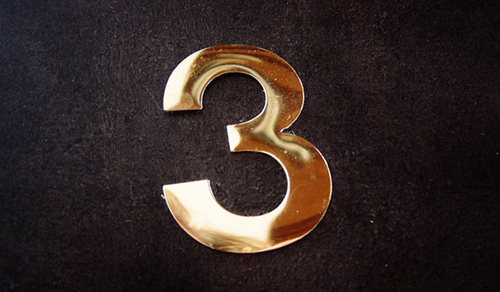
I'm still traveling, so I've commissioned another guest post. The following is a guest post by Bojan Dordevic, who has contributed to the Productivityist blog in the past. Bojan is an Internet marketing professional with a passion for all things productive, and is the co-founder of Alpha Efficiency Magazine. You can invite him for a Hangout on Google+ and follow him on Twitter.
One of the most important decisions that will determine your productivity is choosing a task management and workflow solution that will grow with your needs. When I started this path four years ago, it was important to “future-proof” my task management workflow. I knew that I would not want to change the software that I use as my needs evolved. I recognized the potential for this to become an issue, and anticipated a solution so that once it arrived, I was ready for it. And this is something that ultimately happened when I moved to the U.S. over a year ago.
In evaluating potential solutions, I tried to find a sweet spot: a balance between features, the learning curve required to adopt the workflow, and the usability right out of the box. When choosing future-proof software, we need to be mindful that task management is constantly changing and adapting to new technology. All we need to pay attention to is the real productivity issue that no task manager will solve.
Determining Your Needs in a Workflow Application
So you might ask, “What do I need in a workflow application?” The answer depends on your personal needs. However, I can offer you some things to consider that will help you make the right choice, and to avoid the apps that you might have to switch as your needs change.
First off, it's important to look at the four simple concepts required to efficiently incorporate any task management workflow. Having these four concepts in mind when choosing a task manager can save you a lot of time and energy later down the road.
But apart from that higher level thinking, we need to really focus on three main mechanical – or rather, technical – aspects of any app that you might be considering to handle your workflow:
Is it able to seamlessly collect commitments and digital information?
Can it organize your tasks in a natural way that resonates with the way you think?
Does it have the ability to remove the friction that can prevent you from actually doing the tasks you want?
Most of the apps I've encountered on the market consistently struggle with two of these three points. Even the better apps out there (and those with a higher user adoption) often find at least one of these features a challenge.
1. Collect Commitments and Digital Information
This phase needs to be suited to the environment where you spend the most time. If you spend the majority of your time in a web browser, then the way the system collects information (links) should seamlessly integrate with your existing work patterns.
The solution you choose needs to respond well to your existing workflow environment, so you can quickly and easily achieve your desired workflow, with the least amount of interruption to your activity..
2. Be Able To Organize So It Actually Makes Sense
Solving the problem of disorganized data is more complex than it seems. Often times, it’s not even our fault. As I was evaluating various different forms of software over the past five years, I found that numerous applications have no clear strategy that aligns with the ways we naturally organize information
Organization of tasks, files, emails, links and other commitments needs to have a hierarchical and organic structure that can grow with you. Sure, sometimes a part of the problem lies within our own organizational abilities (or lack of!), and we admit it. But having software that doesn’t think in a fashion that matches how we think confounds the with the rigid structures certainly doesn’t help our mess. This disconnect is actually the biggest reason why I steered away from countless apps. Instead of helping, they were further confounding the mess that was already inside of my head.
3. Remove Friction from Doing
The most important software aspect of task management is to connect the contexts and workspace. When you are writing, you want your workflow manager to take you to the exact file that you are working on. If you need to update your monthly reports, one click or tap should separate you from the actual work. If you find yourself searching, you have already doubled your work: You’ve organized once for the sake of tracking your commitments, and now you need to navigate once again to find the end point of your action.
Integrating tasks, files, emails and links together is the way to go. The apps that can’t handle this integration didn’t challenge the old paradigms, and are yet another “new” version of the old fashioned to-do list. If it comes to that, you might be better off with pen and paper at the end of the day.
The Attitude of the Company Behind Your Solution
Consider that one of the most important aspects behind your software is the engagement of the company that supports it. I believe that a company’s interaction with its own community of users is one of the pivotal factors in determining its quality and long-term success. If your emails don’t receive a reply or, if your suggestions are ignored, you have to wonder whether the company is in it for the long haul, or if it has enough passion to survive. If the support gets discontinued and the development on the app is stalled, you will be dragging feet behind the most modern trends and changes that are shaping your industry.
New product categories will be showing up, new software solutions will become a part of your daily routine, and you will want your workflow to support them. If you feel that a company is passionate about building the software that solves your problems, then you can feel secure in knowing that it will be able to integrate into your workflow in a timely manner.
Note from Mike: I'd be interested to know if you've tkaen these 5 things into account when you chose your task manager. Please let Bojan and I know in the comments below what task management solution you're using, why you went with that solution, and if you feel it fulfills the considerations he's mentioned in this piece.






 Related StoriesThe 5 Zeros You Should Achieve Every Day to Give You Peace of MindHow to Tell if You're Plateauing (and What to Do About It)Productivityist Practices: My Three Months with Bulletproof Coffee
Related StoriesThe 5 Zeros You Should Achieve Every Day to Give You Peace of MindHow to Tell if You're Plateauing (and What to Do About It)Productivityist Practices: My Three Months with Bulletproof Coffee
October 2, 2014
Book Review: Give and Take
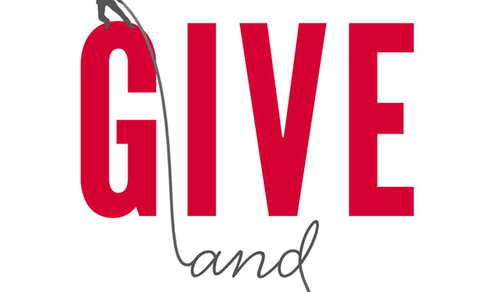
As I continue my travels, I'm offering up a guest post from a regular contributor to the blog, Mike Dariano. Mike offers up book reviews here at Productivityist , and he writes about other things he's learned at People Smarter Than Me. You can connect with him on Twitter at @MikeDariano.
Are you a giver or a taker?
In his book Give and Take: A Revolutionary Approach to Success, professor Adam Grant examines the most successful individuals in a variety of fields and finds one thing they all have in common, they are givers.
Right from the start Grant takes a moment to address that being a giver doesn’t mean giving all the time. It doesn’t mean being a doormat and it doesn’t mean putting the needs of others above your own. Even though these seem like giving ways, Grant brings combines anecdotes, research, and popular stories from history to weave a different fabric that the best workers are made out of. It’s one of giving and how givers do certain things better that bring them an extra advantage.
One of the ways that givers get ahead is through better networking, and not in the traditional sense of selling something to someone. Givers rather, choose to help others and because they give and give, rather than take and take, they have a larger network. In the short run this means a bit of stagnation rather than moving forward but in the long term givers come out ahead. Givers win in the long term because they build up a larger network and help those people get ahead. If a giver needs to call in a favor then, they have a bigger balance of resources to draw from, and probably better results.
Grant also writes about how givers negotiate better than takers. In one study of student negotiators, the group trained as givers got better deals for themselves and their opponents. The researchers concluded that by shifting their thinking toward one of giving, these students were able to find creative solutions to the negotiation impasse they were at. They found things that were of high value to their opponent low cost to them. It was the research manifestation of the children fighting over the last lemon, both claiming they needed it. Only after they stopped yelling and started talking, did they realize one needed the juice for lemonade, the other the zest for pie.
Besides advice on networking, collaborating, evaluating, and influencing, there are sections about avoiding burnout and not being a doormat. To help givers avoid being walkovers Grant suggests many ways to reframe situations, like negotiations. Some givers in Grant’s review of the research were too timid to advocate for themselves. When these givers shifted their thinking from acting for themselves to acting like a mentor for themselves, they shifted into the right frame of giving. One story is of a software engineer who had high qualifications but a low salary. When he shifted from thinking about himself during the negotiations, to thinking about negotiating on behalf of his family he made a stronger - and successful case - for why he deserved a raise.
Overall, I enjoyed Grant’s book. It reads like Gladwell and at times I was wondering if it suffered from some of the same conclusions of convenience, but in the end it passed the sniff test and I highly recommend it. If you enjoyed The Go-Giver by Bob Burg, James Altucher, thoughts on networking or the negotiating classic, Getting to Yes, then Give and Take just might be another book to add to your reading list.






 Related StoriesBook Review: The Up Side of DownBook Review: The Five Elements of Effective ThinkingBook Review: The Obstacle is The Way
Related StoriesBook Review: The Up Side of DownBook Review: The Five Elements of Effective ThinkingBook Review: The Obstacle is The Way
September 29, 2014
The 5 Zeros You Should Achieve Every Day to Give You Peace of Mind
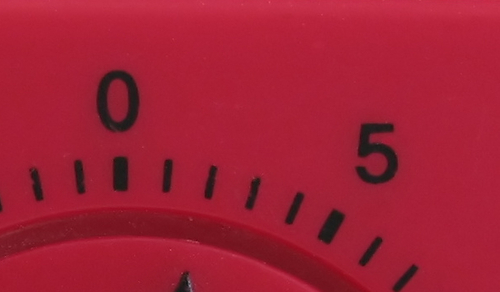
I'm lining up guest posts during my travels over the next two weeks. This post is written by Timo Kiander. Timo is a blogger, author and speaker who helps work-at-home professionals get stuff done fast so that they have time for living. He believes that great results are achieved by overcoming procrastination, improving focus and creating successful productivity habits. If you want to implement the core lessons of this post quicker, you can grab a special checklist created by Timo right away!
I have noticed that the more clutter (either digital or physical) I have around, the more my mind wanders. As a result, I find that I’m unable to focus properly on my tasks.
Without a proper system for handling all the clutter and important input sources, there is a risk that you could miss your next world-changing idea, the crucial meeting that you were supposed to attend to, or you just make your everyday work harder than it is supposed to be.
Building a system for managing the input sourcesIn order to tackle the information and idea overload, I encourage you to reach 5 Zeros every day.
When you reach these zeros, you know that you are on top of your commitments, no idea or task gets forgotten, and no important e-mail is left unanswered.
A brief rundown of these five zeros is as follows:
Task List 0: Creating an effective list of your tasks that you actually accomplish every day (or at least make progress on) Inbox 0: Processing your e-mails and making the inbox empty Tab 0: Processing all open tabs to zero Input 0: Processing all your notes so that every idea, thought or task is handled and scheduled properly Work desk 0: Cleaning your desk after you have stopped workingNow that you know what those 5 Zeroes are, let’s go through the system and how to process them on a daily basis.
Task List 0There was a time in my life when I wasn’t organized or productive at all. My days didn’t have any proper plans and it was no wonder that I didn’t get anything meaningful done.
All this changed when I became interested in learning about personal productivity. One of the first time management lessons that I implemented in my life was having a task list.
Although a task list can give you a solid plan to follow for each day, with improper implementation, this can turn into yet another source of stress and confusion. Rather, your end goal should always be Task List 0 (in other words, all the tasks crossed off your list or at least progress made on them) and with proper planning you can achieve this.
When I plan the tasks for the day, I follow these eight guidelines:
1. I don’t overstuff it.One of the biggest mistakes I have made concerning the task list is having too many items on it. To change this, it all comes down to figuring out how much time you actually have for your tasks and then making a realistic plan according to that.
In my case, I try to have at least three important “big rocks” on my list (aka the most important tasks) and some “gravel” (the less important ones) too. This way I make progress on various levels every day.
2. I make it closed.One of the things I learned when reading Mark Forster’s marvellous book some years ago was to have a closed task list. What this means is that you create a task list as usual, but you after the last task you draw a line, marking the list as closed.
After the list is closed, you can’t add any new tasks to it in the middle of your day. Rather, you can only add new tasks for the next day’s list. The benefit of this is that the number of tasks actually decreases on your list as the day goes by.
Now, it’s naturally easier to draw a line under the last task if you are using a paper-based list. If you are planning your day using a task list application, you can just decide that no new tasks are allowed after your planning session is over.
3. I break the icebergs.Another mistake that I have done with my task list is adding tasks to it which are too big in nature. For instance, publishing a blog post itself is a task for sure, but on its own it’s just too big to fit your list (if you are blogger, you know that publishing a post requires many steps until you can say the task is done). Unfortunately, if you don’t pay attention to the size of the task, you’ll most likely run into nasty surprises.
Picture an iceberg that floats on the water. However, what you see above sea level is just a small part of it. The rest (and most likely a big portion of this icy giant) is under the water, invisible.
It is the same with tasks on your list that are too big. You don’t realise how big they really are until you “hit them” (in other words, start working on them). That’s why it’s necessary to break the big tasks into smaller ones, so that you avoid getting overwhelmed and any nasty surprises.
4. I get the momentum going.Eating the frog (aka the task that you’ll most likely procrastinate on) as first thing is a good strategy to follow, but what if you added a small tweak to it? So rather than starting work on your frog immediately, get the momentum going by doing some smaller stuff off your list first.
Doing this gives you a feeling of accomplishment as you have already finished some tasks. It also gives you more energy to tackle that “frog task” of yours.
5. I’m specific.Don’t spend time on wondering what you meant when your task list says: “Meet Brian”. I don’t know about you but the next obvious questions that pop into my mind are: What Brian? Where do we meet? When do I have to show up?
Rather, keep your task names specific, so that you know right away what to do, like this:
“Meet Brian over at Starbucks on October 20th at 11:30 AM about the book launch”
As you can see, it’s much more specific and you know immediately what you are supposed to do.
6. I include any important reference information.Regarding the previous tip, make sure to have all the necessary task-related information available for you.
For instance, have Brian’s phone number or the address of the coffee shop available just in case you need them. All the tasks lists I have used support adding notes to your task. Definitely use this feature to your advantage.
7. I batch work.Take a look at your task list and figure out if you can do similar things at once. Processing e-mails is one option, and so is making calls or running errands. With a quick look at your list, you can easily spot these kinds of tasks.
8. I use themes.One of the ways I categorise my list is to have themed days and weeks for my work. For instance, I focus on project work from Monday until Thursday, while on Friday I might run errands, and on Sunday I go through some training material.
With themed days, you can focus on just certain types of tasks and make progress easier on them.
Inbox 0Reaching an empty e-mail inbox is probably the most well-known zero of the list. The main idea is to keep your inbox clean and all the messages processed, so that no digital clutter accumulates in your inbox.
Too often people complain that their inboxes are bloated and too difficult to handle. Not only are all the important messages there, but the inbox contains less-important messages as well, like newsletter items, jokes from colleagues or your friend asking you to go to lunch with him.
Yes, I was one of those people, but at some point the situation became too difficult to handle and I wanted to become more organized in this particular aspect. That’s why I decided to reach inbox 0, knowing that every message I was dealing with was going to be processed somehow.
So how do you reach Inbox 0 then? My way is an adapted version of Kosio Angelov’s OTR-technique, and the basic foundation is this:
Checking e-mail three times per day (you can decide those times at least don’t start your day with your inbox) Process all the messages at once (with one touch if possible)In addition, I take these additional steps:
I have activated the Send and Archive button in Gmail (puts the processed messages into archive). When I open the inbox, I scan the headlines and unsubscribe from the e-mail lists that don’t interest me anymore (you can also use a tool to make this easier). If the e-mail was sent by a service, log-in immediately to the service and change its settings so that no new notifications come in. I archive/delete the messages with headlines that aren’t of any interest to me. Once I have a “real” message that contains an assignment, I put a note about it to my task list. Also, I add the URL of the e-mail message as reference in the description field (if your task list software supports this), in order to access the e-mail later. After this, I archive the message. If I encounter a message that I can’t reply to right away, I put a note to my task list, add a link to the message in the notes field and define a time when I’m going to reply to the message.With the previous steps, I can maintain inbox zero every day. Steps 4 and 5 ensure that I’m able to process the messages properly and that the necessary follow-up steps are planned accordingly.
Tab 0With the advent of tabbed browsing some years ago, it wasn’t necessary to keep that many browser windows open anymore and there was a much smaller risk of crashing your browser (especially on the Windows machine).
Although the tabs improved the browsing user experience considerably, they exposed another issue: All of a sudden, and if you weren’t careful enough, your browser would have dozens and dozens of open tabs, making the browser slow to start and operate yet again.
I was having this problem until I decided to create a similar kind of approach to tabs as there was for processing e-mail. And that’s how Tab 0 was born.
In essence, the idea is to process all the open tabs to zero (on a daily basis) so that your browser can become manageable again.
Reaching Tab 0 is a simple and straightforward process when you follow these guidelines:
1. Ask why.Why is this tab open? If you can’t find any reason for doing so, close it right away
2. Understand the purpose.Ask yourself the following:
Is your tab open because you are doing research? Is it because you want to read the post later on? Is it because it contains a tutorial you are going to implement soon? Is it because you want to access on online training resource late on?In any of these cases, create a task based on the purpose of an open tab and schedule it! This way you are not keeping all the tabs open all the time, only when you are truly need them with your work.
For instance, if I’m working on a project, I make sure I put the URL of the open tab to the task notes, so that I can access the page later, as seen in the image below
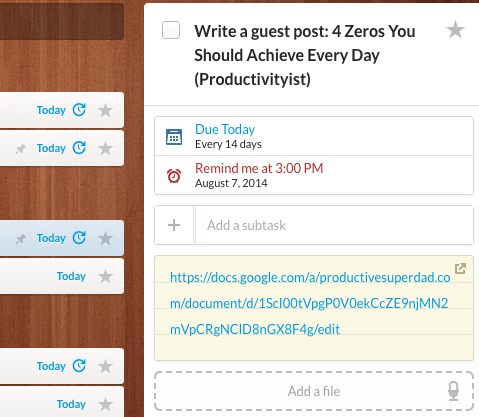
As you can see, the link to the document in progress is neatly listed as a reference, not as an open tab. Once all the tabs are processed, you can start your day with only one tab when your browser starts.
Input 0Next thing to do is to deal with all the input sources including things like:
Your mobile phone Your paper-based notes on your desk Your “distraction list” All the regular mail that you haven’t processed yet Meeting notesThe basic idea is to go through all the input sources and process them at once every day. When you do this on a regular basis, all the ideas gets stored and all the assignments get scheduled.
One particular (and handy) way to enhance your working focus is to have something I’d like to call a “distraction list”.
It’s nothing more than just a piece of paper on my desk, where I jot down every idea, task and thought that crosses my mind when I’m working.
At the end of the day I process this document and make sure that the items get either done right away (if they take just couple of minutes) or they are scheduled accordingly.
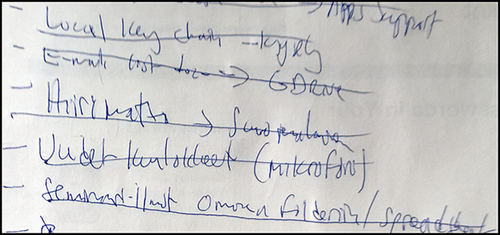
Indeed, my distraction list looks messy. Then again, this list helps me to focus better.
Work desk 0So what is a work desk zero anyway? Well, it’s nothing more than the habit of keeping your physical work desk clean and uncluttered.
Naturally you may have all your papers and other stuff on your desk when you work, but there is nothing better than returning back to work with a clean and organised desk.
Once again, this is just a matter of processing the workspace at the end of the day and making sure that:
All the unnecessary papers are thrown into the trash, shredded or recycled All the research material is put where it belongs All the office supplies are put back in place The desk looks neat when you stop working for the dayDoing this small clean-up should take just couple of minutes maximum, so don’t skip this step!
Making The 5 Zeros StickNow that you have gone through all the five areas related to your work, you can call it a day. But how do you make this a habit that will stick?
I've created a checklist that outlines the core ideas of this article so that you can see the important points at once. I've also added some bonus materials to this checklist, such as suggesting tools that can support you on your journey to achieve the zeros and offering up some additional tips that make your workday even more productive. So if you’d like to make a big jump in your daily productivity, click here and download this checklist today.






 Related StoriesHow to Tell if You're Plateauing (and What to Do About It)Productivityist Practices: My Three Months with Bulletproof CoffeeHow to Score Productivity Touchdowns During Football Season
Related StoriesHow to Tell if You're Plateauing (and What to Do About It)Productivityist Practices: My Three Months with Bulletproof CoffeeHow to Score Productivity Touchdowns During Football Season
September 25, 2014
Yes Before No
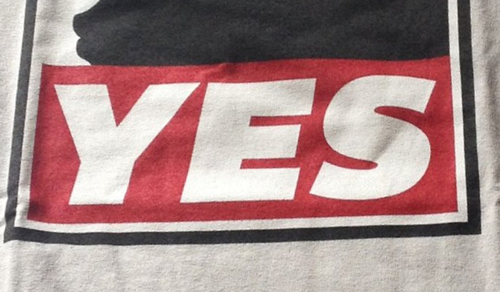
I still have a hard time saying “no” to things.
I’m getting better at it all the time, but that doesn’t mean I find it easy. Why? Because I’m naturally a “yes” person – and I’ve gotten used to saying yes over the years. In fact, I’d argue that all of the times I said yes has allowed me to start saying “no” more often.
As a trained improviser, I was taught to say yes to every offer. My friend Dave Morris has discussed the power of saying yes in his excellent TEDx talk The Way of Improvisation, and I’ve seen how well things play out when everyone is accepting of the offers being laid out to them in an improvised scene. It’s magical for the audience to see and for the performers to deliver, but it’s even better when another word is added to the end of the yes. That word is “and.”
By tagging on that very powerful word, you start building something more out of that yes. It allows for innovation to happen, which is even more magical. It gives your fellow players more to work with, and moves the scene forward.
That’s what a yes can do for you…and what it’s done for me.
I’ve gotten better at adding that “and” to the end of my yes answers. I’ll offer to attend an event and then figure out what else I can do that scales beyond the basic scope of the commitment to make it more valuable for me. That allows me to move myself and my work forward. Frankly, the “and” has done its part in helping me move towards a no answer in a lot of ways. If I can’t find anything of additional value outside of the scope of the commitment , then I’ll be better equipped to turn the opportunity down.
When I first started out building up Productivityist, I took on a lot of projects and obligations for several reasons. These were my “and” value-adds. The big three value-adds that often drew me to saying yes to commitments were as follows:
1. Skill Development
There’s no way I’d have been able to develop my skills as a writer, speaker, and teacher if I didn’t accept the offers to take part in events and teach workshops for far less than I make now for those sort of things. I built up my confidence, built up my proficiency, figured out what I needed (and what I didn’t need) to have at my disposal, and learned what worked and what didn’t. I’m still learning, and I’m still doing events and workshops for less than my going rate (although those are fewer and farther between now). I’ll examine opportunities and see if I can develop a skill I want through them. If so, I’m more likely to say yes. If not, then I have no problem saying no.
2. Improved Judgement
I would have no idea what to agree to and what to turn down if I had no frame of reference. Saying yes has given me that frame of reference. I have been able to figure what works for me and what doesn’t for the most part because I’ve agreed to a wide variety of commitments over the years. I’ve learned what my boundaries are and where to place them. I’ve become far better at identifying the value-adds in an opportunity and when the opportunity just doesn’t align with my values or line of thinking. By accepting a ton of opportunities over time, I have honed my ability to better evaluate opportunities that come my way and judge them accordingly.
3. Building Authority
If I had stayed home instead of putting myself out there, I wouldn’t have as much authority in my field. Since I’ve made appearances at events like South By Southwest, New Media Expo, TEDx, creativeLIVE, and more, I’ve built up my authority. If I had said no to more opportunities than I said yes to when I was beginning my journey with Productivityist, then the company and my own reputation would not have spread nearly as far as it has. I’ve started down the right path by building authority organically through event attendance, putting my writing work out there beyond the walls of this website, along with other efforts that I know are valuable. All of that has come through saying yes a whole lot before uttering my first “no.”
Saying no is definitely worthwhile as it allows you to focus on what matters most as opposed to splitting your focus among multiple commitments. But don’t discount the “yes” because it’s what will help you figure out the “no” stuff now…and in the future.






 Related StoriesDon't Just Ship...DeliverRetreat, Reset, Results: Why We Need to Step Back More Often to Boost ProductivityWhat's The Next Horizon?
Related StoriesDon't Just Ship...DeliverRetreat, Reset, Results: Why We Need to Step Back More Often to Boost ProductivityWhat's The Next Horizon?
September 22, 2014
How to Tell if You're Plateauing (and What to Do About It)
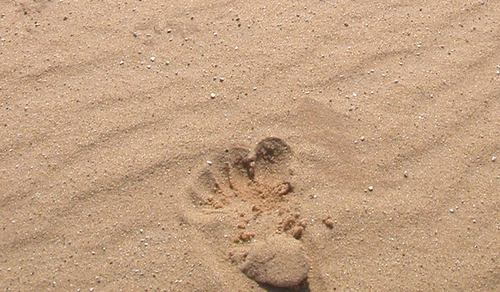
The following is a guest post by Kayla Matthews. Kayla is a productivity blogger with a passion for self-improvement and finding happiness. To read more articles by Kayla, you can find her at Productivity Theory, as well as on Google+ and Twitter.
I guess we most commonly associate plateauing with age.
People say that you plateau when you get older; that you level off and no longer become better at anything because your body and mind are tired.
That’s a load of garbage.
I’ve known people younger than myself who have already plateaued and I’ve know people much older than myself who are way more physically and intellectually fit that I’ve ever been.
My point is that you’re never too young or old to stop trying, but you’re also never too young or old to do something about it.
My goal with this post is to help you realize if you’ve stopped trying to better yourself, to show you why it’s important to keep pushing and to help you find ways to improve any lack of motivation you may have towards the latter.
How to tell if you’ve leveled offWe all get busier as we get older. You get out of college and start working and, suddenly, what you thought was very little free time becomes a whole lot less. Or maybe you started working immediately after high school and spend the majority of your time doing manual labor. Either way, we tend to start making excuses for ourselves about why we can’t learn something new, or exercise, or give our time to others.
"I’m too (insert reason/excuse here) to (insert the thing you're should do here)." The statement of a chronic plateauer.
If you find yourself thinking and saying things like this often throughout each day, it’s likely that you’ve already plateaued.
I mean things like “I’m too busy to do that” and “I have too many deadlines to do this.” Not statements like “I’m too sick to go to the gym.” You do need to know your limits and this latter example is a responsible and healthy choice.
I mean when you make excuses for yourself about why you can’t try something new or change your routine. I understand that you feel swamped with everything that’s on your plate already and you don’t want to take on more. But what are you really gaining by not trying to improve yourself and test your limits?
You might think you’re gaining time. But time to do what? To sit in front of the TV and watch everything around you pass by?
If you want more for yourself than that – if you want to be an active participant in your own life – then I want to make you specifically aware of the fact that you can do whatever you want with your life, whenever you want. It can even seem quite easy if you approach it with the right mindset.
But why should you try? Why should you give up precious hours of your day to train for a 5K, or learn a new language, or - what the hell - learn woodworking?
Why plateauing is badUnfortunately, plateauing is socially acceptable in our society (that of the U.S.) and people who go above and beyond to improve themselves throughout their lives are seen as the “overachievers.”
But allowing yourself to level off is bad for a number of reasons.
For one, you don’t get nearly as much satisfaction out of your life when you allow yourself to only go through the motions. When you decide that you want to learn something new or get healthier, you start setting goals for yourself. And each time you meet one of those goals you feel awesome.
Two, you don’t realize your full potential. If you let yourself plateau and never make new, meaningful goals for the kind of person you want to be, you might go through your entire life thinking “Oh, I’m just your average so-and-so.”
When you strive to do new things, you find that you can surprise yourself, which can be a huge confidence-booster.
Thirdly, you don’t enjoy the small things in each day. Putting away laundry and cleaning up after your pets or kids might not be the number one thing you’d like to do. But when you get daily satisfaction out of hobbies that you choose to participate in, doing the normal stuff doesn’t seem so bad.
Your day is overall more enjoyable and you’re more productive in your daily tasks because you aren’t a grumpy mess.
There are plenty of other reasons why plateauing is bad. Its keeps you from growing as a person, it limits the ways in which you can contribute to society - it limits the ways in which you see yourself.
But now it’s time to talk solutions. Say I’ve actually interested you in breaking up that plateau. What actions can you take to shake things up in a healthy and productive way?
What you can do to unplateau yourselfI don’t expect you to suddenly start CrossFit training (but if you want to I would certainly support the idea!). There are a number of small things you can start doing to create some excitement in your day without disrupting your usual productivity levels. Here are just a few of them:
1. Make realistic goals for yourselfOne of the quickest ways to get out of your slump is to start setting goals for yourself. However, if you set goals that are too easy or totally unrealistic, you aren’t going to feel very satisfied with yourself when you complete them.
Another common oversight we make when setting goals is that we don’t set them for ourselves. We set them for our boss or our family. While striving to do well at work and at home is great, it isn’t a goal for you.
If you really want to get off your plateau, you need to set a goal for yourself about something that is important to you and that you can achieve alone (you’re certainly welcome to include others in reaching your goal, but it shouldn’t be necessary).
For example, if the way you want to better yourself is by getting in shape, don’t set the unrealistic goal of jogging 5 miles the first time you go running. Just make a goal to go running two or three times your first week, and then bump up your goals from there.
2. Nip negative statements in the budOne of the main reasons we plateau in life is because we allow ourselves to think in negative ways. Remember my earlier example of "I’m too (insert reason/excuse here) to (insert the thing you're should do here)?" It's a perfect example of a negative statement. You’re saying that you can’t do something because something else is getting in the way.
It can be really difficult to change the way your brain is wired, so if you have a hard time preventing negatives statements from slipping in, just change the way you think about them. My favorite way to do this is to follow up a negative statement with “but…”
For example, “I’m too busy to go to the movies, but I bet I could go to the movies and finish up the rest of my work later.” Once you add the “but” after the negative statement, it becomes a lot easier for your brain to think of a positive solution to the problem.
Part of keeping yourself from leveling off in life is keeping a positive attitude and, for me, this has been one of the most helpful ways to do so.
3. Don’t feel bad when you failFailure is all a part of making sure that you don’t plateau. The way I see it, if you imagine a straight plateau, a few (or even many) pitfalls in the dirt are way more interesting than one straight, boring plane.
Use any failures you experience to motivate your future successes. Feel great about the fact that you tried and failed as opposed to never trying at all. It might sound a little cheesy, but perspective is optional and how you choose yours will influence how happy and satisfied you are with your life.
If you made it all the way through this post, I’m proud of you. It’s a long one. Let it be the first of many successes and failures as you strive to improve your life, productivity and positivity in the future.
If you have any questions or comments, I’d love to hear them. You can share them in the comments section below.






 Related StoriesProductivityist Practices: My Three Months with Bulletproof CoffeeHow to Score Productivity Touchdowns During Football SeasonHow to Make Monday Work for You
Related StoriesProductivityist Practices: My Three Months with Bulletproof CoffeeHow to Score Productivity Touchdowns During Football SeasonHow to Make Monday Work for You
September 19, 2014
A Look at Productivity and Workflow "Versioning"
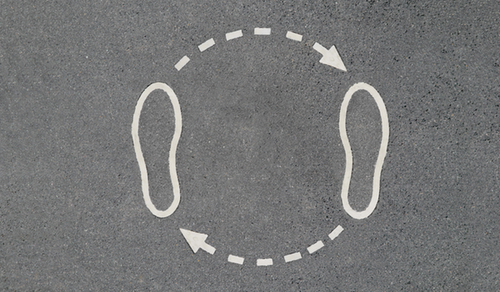
I've found that over the years my workflow and productivity tactics haven't just evolved. I'd suggest they've also gone through a "versioning" of sorts, which is very different than evolution. Let me explain.
The word version is derived from the Latin word vertere, which means "to turn." The word evolve comes from the Latin word evolvere, which means "to unroll.” My workflow has certainly evolved over the years, but every time I’ve somewhat “unrolled” a new workflow element, whether it is through something like The Strikethrough System or moving to Todoist as my task management solution, I’ve also created a new version of my workflow. The evolution is part of the process, but the versioning is the finality of that process.
Let’s examine what Apple released this week in these terms. The new iPhone is not so much an evolution of the device as it has evolved leading up to the release of the new iPhone 6 (and iPhone 6 Plus). But with the release of these new devices, new versions have come into play. Evolution of the device has made it better over time, as the definition of the term suggests, but the new version creates a new pillar - a new starting point - and one can clearly look back and see each version as a pillar during the evolution of the device. The same goes for iOS. The new version of Apple’s mobile operating system has taken into account all of the things that iOS 7 offered, added some elements that users clamoured for, and borrowed elements from third party developers to create a better version than its predecessors.
The same goes for the Kindle. Amazon announced a new version of the e-reader called KindleVoyage that improves upon the Paperwhite. In fact, this version will be the first Kindle I buy because of that. This version is the one I’ve been waiting for. It’s the one that will replace my Kobo Mini and firmly push me into the Amazon Kindle side of the e-reading pool. The evolution of the Kindle led to the version known as (fittingly named) Kindle Voyage.
The same goes for digital products. Asian Efficiency looked at its OmniFocus Premium Posts product and decided to evolve it, eventually creating a new version of it. By changing it from PDFs and videos to an online course, they’ve taken it to new heights and improved the overall experience. This versioning creates a very clear distinction between its predecessor and successor.
And the same goes for the way we operate.
My workflow has evolved over the years, creating a new version of the way I work. Through the approach I take, the apps I use, and my relationship with all of those things, I have created a new pillar that I can say is a versioning of my workflow. I can look back at my days of OmniFocus use and see a different version, but know that I’ve taken elements of that version and applied it to the one I’m using today. I can look back at all of the writing tools I use before and understand why working with Scrivener now is better for the way I operate (with credit going to Joseph Michael’s Learn Scrivener Fast course for helping me realize that). The way I used Evernote before isn’t even close to how I use it now, and I know that the way I use Evernote down the line will differ from how I use it now. I know that the way I use other apps will also change over time, fostering a better workflow and, as a result, a better version of my work.
When you start to look at the way you work and the systems you have in place to help you with that work, that’s the beginning of a new version of your workflow. It begins to evolve. You add tried and tested frameworks and apps, which become part of your workflow. Then the work becomes easier to do and involves less friction. You’ve evolved into Version 1.0.
Then you tweak that version to better suit your needs, perhaps through changing how you use an app or changing apps altogether. Doing so evolves that version until it improves upon your workflow enough to make the work even easier to do and removes even more friction from your workflow. Now you’re at Version 2.0.
And the evolution continues, along with the versioning.
Keep in mind that you can spend too much time versioning, which isn’t the idea here. Versioning needs to be deliberate. It needs to signify landmark occasions. After all, when you turn too much you usually wind up going in circles.
The idea is to let evolution carry you down the path, and let versioning help you craft the ideal path for you.






 Related StoriesThe Quest for "Just Right"A Simple 3 Step Filter to Give You ClarityCraft Your Wildly Productive Day with 3 Important Questions
Related StoriesThe Quest for "Just Right"A Simple 3 Step Filter to Give You ClarityCraft Your Wildly Productive Day with 3 Important Questions
September 15, 2014
Productivityist Practices: My Three Months with Bulletproof Coffee
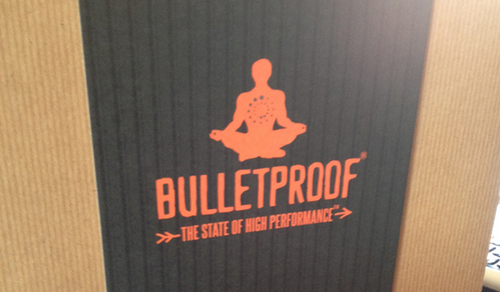
Productivityist Practices is a new series where I spend an extended period of time – usually three months – with a particular approach, product, or service. At the end of the trial, I'll decide whether or not I want to keep it as part of my routine, adjust it so that it might fit better into my routine, or ditch it altogether. The purpose of these experiments is to thoroughly test and review things so that you, the reader, don't necessarily have to. Enjoy!
Bulletproof Coffee is a drink that has been widely touted by Dave Asprey, The Bulletproof Executive. I met Dave at SXSW and thought I’d give the connection a try after reading more about it. Bulletproof Coffee is a mixture of coffee (ideally mycotoxin-free coffee), two tablespoons of grass-fed butter, and two tablespoons of MCT oil. You can learn how to make it right from the source.
Before I dive into what I’ve noticed during my Bulletproof Coffee experiment – which has lasted for nearly three months at this point – I’ll walk you through my morning process in terms of where the Bulletproof Coffee fit in:
Wake up. Splash water on my face. Drink a glass of water. Make a Bulletproof Coffee with my AeroPress using the recommended beans during work days and make a regular AeroPress coffee with other beans during non-work days. Enjoy my coffee of choice while reading and (eventually) writing.Now, about my discovery during this Bulletproof Coffee experiment…
First off, I actually like the taste of it. As someone who is big on black coffee, this took me by surprise. I didn’t think the creaminess of it would sit well with me, but it does. I don’t drink it every day – I drink regular coffee on my Daddy Duty days and on Saturdays – but when I do, I rather enjoy it.
Secondly, I have noticed that I’m not as hungry after drinking it. I presume that’s due to the butter and MCT oil. I can usually wait longer to eat on the days I start off my morning with Bulletproof Coffee, although I rarely do. I still have a shake/blend made in our NutriBullet on most days after drinking my Bulletproof Coffee. I don’t think it’d be the best for me to simply get by on the coffee alone.
Thirdly, I didn’t really notice a difference between the beans that came with the kit and the ones I’v bought since. I think the key is to use high-quality beans, and I’ve been doing that for the most part. I also didn’t bother with a Vitamix blender. I’ve been using a normal household blender (read: cheap) to make my morning drink. To be fair, the first blender didn’t last very long, but the new one seems to show promise. It’s designed to deal with warm liquids better, so it should stand up to the rigours of blending my coffee four times a week.
I’ve read criticisms about Bulletproof Coffee in terms of taste and they don’t fly with me. It taxes more like coffee than I thought it would, albeit very creamy coffee. As for the health benefits, I’d say I haven’t been affected positively or negatively by it at this juncture. Perhaps that’s because I haven’t used it as breakfast replacement but simply as my morning coffee replacement. However, I also haven’t had my cholesterol looked at since starting my Bulletproof Coffee trial, and some research on that matter does concern me. An article published by Authority Nutrition has made me think twice about continuing with the trial, as I’ve not noticed anything drastic in my energy levels since drinking it. I’m not sure if the slight benefits (for me, at least) outweigh the reported risks.
(To be clear, there is no clear evidence on either side of the argument about the possible risks of drinking Bulletproof Coffee regularly. It’s definitely worth researching for yourself to see what argument you tend to side with more despite the lack of clear evidence.)
After drinking Bulletproof Coffee for several weeks now, I’m going to take a break from it for a while. I want to see if I notice any change in my energy levels, and I’d like to spend more time doing research on it before taking it up again. Folks like Tim Ferriss, Ari Meisel, and Dave Asprey himself are far more versed in the aspect of personal productivity known as “bio-hacking,” and I largely look to them for new ideas and innovations in that space. But for now Bulletproof Coffee leaves me with more questions than answers, and that means it needs to be removed from my daily routine.
If you’ve given Bulletproof Coffee a try, I’d love to hear about your experience in the comments below.






 Related StoriesHow to Score Productivity Touchdowns During Football SeasonHow to Make Monday Work for YouThe One Productive Weekly Meeting You're Not Having (But Should)
Related StoriesHow to Score Productivity Touchdowns During Football SeasonHow to Make Monday Work for YouThe One Productive Weekly Meeting You're Not Having (But Should)



